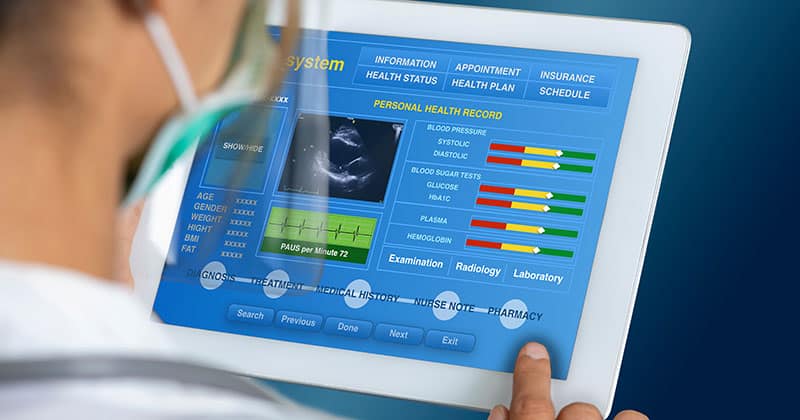Enhancing Accuracy and Efficiency with AI-driven Coding and Billing Solutions
The medical coding and billing process is often complicated and inefficient, leaving he...
January 23, 2024
Any healthcare provider knows that having access to all of a patient’s health information is crucial not only to an accurate diagnosis but also to creating a proper and timely treatment plan. It’s not enough to simply have access to it. Providers need to be able to locate pertinent aspects quickly.
Locating integral details can be cumbersome and time-consuming, especially when dealing with old systems or an overload of paperwork. It makes a provider’s job more tedious and error-prone. Patients may experience frustrating delays in treatment, leading to avoidance and poor outcomes.
A solution that’s gaining traction in healthcare is incorporating advanced technologies to facilitate communication between providers and make patient data more accessible, leading to improved patient care.
Electronic health record (EHR) systems let providers keep and share all patients’ health information in one digital location. Increased accessibility allows healthcare professionals to quickly find what they need. This includes medical history, prescriptions, current treatment plans and conditions, and other vital statistics.
In this article, we will talk about the future of EHRs. We’ll review things like EHR systems interoperability, maintaining privacy and security while using the cloud, and even how smartwatches can help track patient health.
We’ll also share actionable steps to introduce these new EHR features into your practice. This can help you improve your operations and ensure optimal patient care.
FROM ONE OF OUR PARTNERS: The Future of Telehealth: Predictions and Trends for the Next Decade
EHRs aren’t completely new. However, EHR systems have changed a lot since they were first introduced in limited capacity in the 1960s. They have since done away with paper records, moving them to computers and, more recently, the cloud.
EHRs now let providers store all the patient’s health information in one place. This helps them make fully informed choices in patient care.
They also allow healthcare providers across different clinics and specialties to access the same information. This provides a faster and more detailed understanding of a patient’s healthcare needs—even if it’s a first-time visit. Wait time is drastically decreased when records are available on-demand, benefiting both provider and patient.
EHRs also help prevent medical error. When providers have all the necessary data, it helps reduce medication conflicts, testing or lab duplication, unnecessary appointments, and other potential patient safety issues. This leads to improved patient outcomes.
RELATED ARTICLE: What Does the Future of Patient Engagement Look Like?

EHRs are consistently adjusting and improving healthcare for both providers and their patients.
Let’s look at the future of EHRs:
Cloud computing means providers have secure access to health records from anywhere. This is advantageous for busy clinics while still keeping patient data secure.
It’s like having an indecipherable lock on all health records. With securely encrypted cloud storage, doctors can immediately view the data they need with fewer risks.
Blockchain is an encryption technology that stores health records in a very secure way.
When information is added, it’s put into a block with a unique code. Each new block is linked to the previous one, creating a chain.
This method makes it difficult for anyone to change the information once it’s been added, keeping the records safe and accurate.
EHRs and telehealth can be used in tandem, allowing providers to care for patients remotely.
This is beneficial for patients because they can access the same standard of care without having to travel. It increases access to healthcare for patients who face transportation challenges, which reduces avoidance and missed appointments.
Telehealth data can be linked to EHRs so that they remain current.
Internet of Things (IoT) devices are becoming more prevalent in healthcare. They help monitor patient health and communicate stats with their doctor.
AI can help doctors listen to patients and create written notes. This helps with not only documentation, but allows them to focus on patients.
Biometrics is another tech trend affecting security protocol. Instead of passwords, patients use a fingerprint or other biological feature to access their health data.
Nearly 80% of patients said yes to using facial biometrics. This shows they like using technology to access healthcare securely and remotely.
RELATED ARTICLE: Why Your Urology EHR Needs Smartphone Technology Capabilities
More people are using health devices like smartwatches. In fact, 14.4% of people old enough to work and use the internet have one of these wearable devices.
Wearable tech can do more than send a text, it can monitor certain aspects of a patient’s health and share them with their EHR. This helps providers see more real-time data on their patients as they go about their lives.
Now, there’s a big push to make all EHR systems work together better.
With the ability to connect EHRs with other systems and devices, providers can get all patient health information in one place. EHR interoperability helps coordinate care for patients, especially those with chronic or complicated health issues.
Real-time data allows providers to monitor patients’ vitals and detect any deterioration in their condition. Any changes are immediately available in the patient’s EHR, empowering the provider to adjust treatment and prioritize by urgency. Having a full picture of a patient’s condition as it progresses leads to better patient outcomes.
Analytics allows healthcare providers to assess patients’ EHRs more thoroughly by providing concrete data and identifying patterns that can assist in diagnosis. About 50% of doctors and hospitals plan to use advanced analytics and machine learning to suggest treatments and make some steps automatic.

Here are some hands-on steps healthcare practices can take immediately to use the latest EHR trends:
Check for updates on EHR regulations. Ensure your practice is always compliant and making the most of new opportunities.
Research different cloud-based EHR providers. Find one that fits your practice’s needs and budget. Look for services with strong security measures and good reviews from other healthcare providers.
Set up training sessions for your team on the latest EHR features and best practices. This ensures everyone knows how to use the system efficiently and securely.
Identify tasks that can be automated. This might include appointment scheduling or data entry. Integrate automation tools into your EHR system to save time.
If you haven’t already, start offering telehealth services. Ensure your EHR system is fully integrated with your telehealth platform to streamline patient care.
Faster internet technologies are constantly being introduced. Verify that your EHR system and practice’s infrastructure can handle increased data speeds and volumes.
Look at your EHR system’s data analytics tools. Gain insights into patient care trends, treatment outcomes, and operational efficiencies. This helps to better inform decision-making.
FROM ONE OF OUR PARTNERS: 9 Trends for the Future of Medical Practices Everywhere